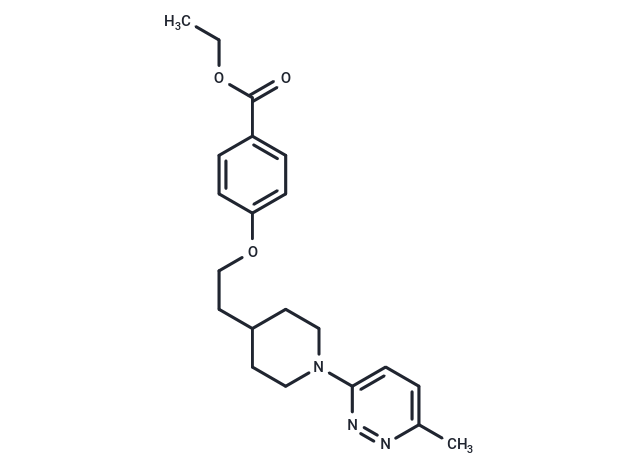Shopping Cart
Remove All Your shopping cart is currently empty
Your shopping cart is currently empty
Pirodavir (R77975) (R 77975), the prototype of broad-spectrum anti-picornavirus compounds, is a potent human rhinovirus (HRV) capsid-binding inhibitor.

| Pack Size | Price | USA Warehouse | Global Warehouse | Quantity |
|---|---|---|---|---|
| 2 mg | $37 | In Stock | In Stock | |
| 5 mg | $59 | In Stock | In Stock | |
| 10 mg | $103 | In Stock | In Stock | |
| 25 mg | $233 | In Stock | In Stock | |
| 50 mg | $371 | In Stock | In Stock | |
| 100 mg | $526 | In Stock | In Stock | |
| 200 mg | $713 | In Stock | In Stock | |
| 1 mL x 10 mM (in DMSO) | $68 | In Stock | In Stock |
| Description | Pirodavir (R77975) (R 77975), the prototype of broad-spectrum anti-picornavirus compounds, is a potent human rhinovirus (HRV) capsid-binding inhibitor. |
| In vitro | Pirodavir is a potent, broad-spectrum picornavirus inhibitor with significant efficacy against various human rhinoviruses (HRV) and enteroviruses. It inhibits 80 out of 100 HRV strains at 64 ng/mL and shows comparable activity against 16 enteroviruses with an IC80 averaging 1,300 ng/mL. Additionally, Pirodavir suppresses enterovirus 71 replication with an IC50 of 5,420 nM and an IC90 exceeding 13,350 nM. It inhibits 56 rhinovirus laboratory strains and three clinical isolates, achieving a 59% inhibition rate for tested serotypes and isolates at IC50 values below 100 nM. Cytotoxicity studies show Pirodavir concentrations of 16 and 4 μg/mL reduce cell growth by 66% and 28%, respectively, and higher tolerance in confluent HeLa cells at 33°C, where the 50% cytotoxic concentration exceeds 50 μg/mL, compared to 7 μg/mL for logarithmic cell growth at 37°C. These findings underscore Pirodavir's efficacy as a selective picornavirus inhibitor with minimal cytotoxic effects under specific assay conditions. |
| Kinase Assay | The extract and binding assay buffer consists of 25 mM sodium phosphate, 10 mM potassium fluoride, 10 mM sodium molybdate, 10% glycerol, 1.5 mM EDTA, 2 mM dithiothreitol, 2 mM CHAPS, and 1 mM phenylmethylsulfonyl fluoride (pH 7.4), at room temperature. Intracellular receptors produced in this fashion exhibit reproducible interaction with known ligands at the published affinity. These preparations are subjected to extensive quality control experiments before the assays, covering receptor response, specificity, size, and reference ligand affinity. Receptor assays are performed with a final volume of 250 μL containing from 50-75 μg of extract protein, plus 1-2 nM [3H]Dex at 84 Ci/mmol and varying concentrations of competing ligand (0 to 10 μM). Assays are set up using a 96-well minitube system, and incubations are carried out at 4°C for 18 h. Equilibrium under these conditions of buffer and temperature is achieved by 6-8 h. Nonspecific binding is defined as that binding remaining in the presence of 1000 nM unlabeled Dex. At the end of the incubation period, 200 μL of 6.25% hydroxyapatite are added in wash buffer (binding buffer in the absence of dithiothreitol and phenylmethylsulfonyl fluoride). Specific ligand binding to receptor is determined by a hydroxyapatite-binding assay. Hydroxyapatite absorbs the receptor-ligand complex, allowing for the separation of bound from free radiolabeled ligand. The mixture is vortexed and incubated for 10 min at 4°C and centrifuged, and the supernatant is removed. The hydroxyapatite pellet is washed two times in wash buffer. The amount of receptor-ligand complex is determined by liquid scintillation counting of the hydroxyapatite pellet after the addition of 0.5 mM EcoScint A scintillation cocktail from National Diagnostics[1]. |
| Cell Research | Pirodavir (R 77975) is dissolved in DMSO (10 mg/mL) and stored, and then diluted in growth medium before use[2]. HeLa cells are seeded at a concentration of approximately 180,000 cells per dish in six-well plates containing 4 mL of growth medium. Growth medium consist of Eagle's basal medium, supplemented with 5% fetal calf serum, 2% sodium bicarbonate, and 1% glutamine. After 24 h of incubation at 37°C in a humidified CO2 atmosphere, the growth medium is removed and replaced by the test solutions (fresh growth medium with or without various concentrations of the antiviral compounds). To assess the cytotoxicity of the antiviral compounds (e.g., Pirodavir), the number of living cells are determined present in triplicate cultures at the time of Pirodavir addition and every 24 h for 3 days. Following trypsinization, the number of viable cells for each drug concentration is counted in triplicate with a Coulter Counter[2]. |
| Synonyms | R77975 |
| Molecular Weight | 369.46 |
| Formula | C21H27N3O3 |
| Cas No. | 124436-59-5 |
| Smiles | CCOC(=O)c1ccc(OCCC2CCN(CC2)c2ccc(C)nn2)cc1 |
| Relative Density. | 1.137g/cm3 |
| Storage | Powder: -20°C for 3 years | In solvent: -80°C for 1 year | Shipping with blue ice/Shipping at ambient temperature. | |||||||||||||||||||||||||
| Solubility Information | DMSO: 11 mg/mL (29.77 mM), Sonication is recommended. | |||||||||||||||||||||||||
| In Vivo Formulation | 10% DMSO+40% PEG300+5% Tween 80+45% Saline: 1 mg/mL (2.71 mM), Sonication is recommended. Please add the solvents sequentially, clarifying the solution as much as possible before adding the next one. Dissolve by heating and/or sonication if necessary. Working solution is recommended to be prepared and used immediately. The formulation provided above is for reference purposes only. In vivo formulations may vary and should be modified based on specific experimental conditions. | |||||||||||||||||||||||||
Solution Preparation Table | ||||||||||||||||||||||||||
DMSO
| ||||||||||||||||||||||||||
| Size | Quantity | Unit Price | Amount | Operation |
|---|

Copyright © 2015-2025 TargetMol Chemicals Inc. All Rights Reserved.